You can still have the privilege of having your space beautified with gorgeous-looking houseplants even if you are hardly ever around, very occupied with other things, or not quite an expert on growing plants.
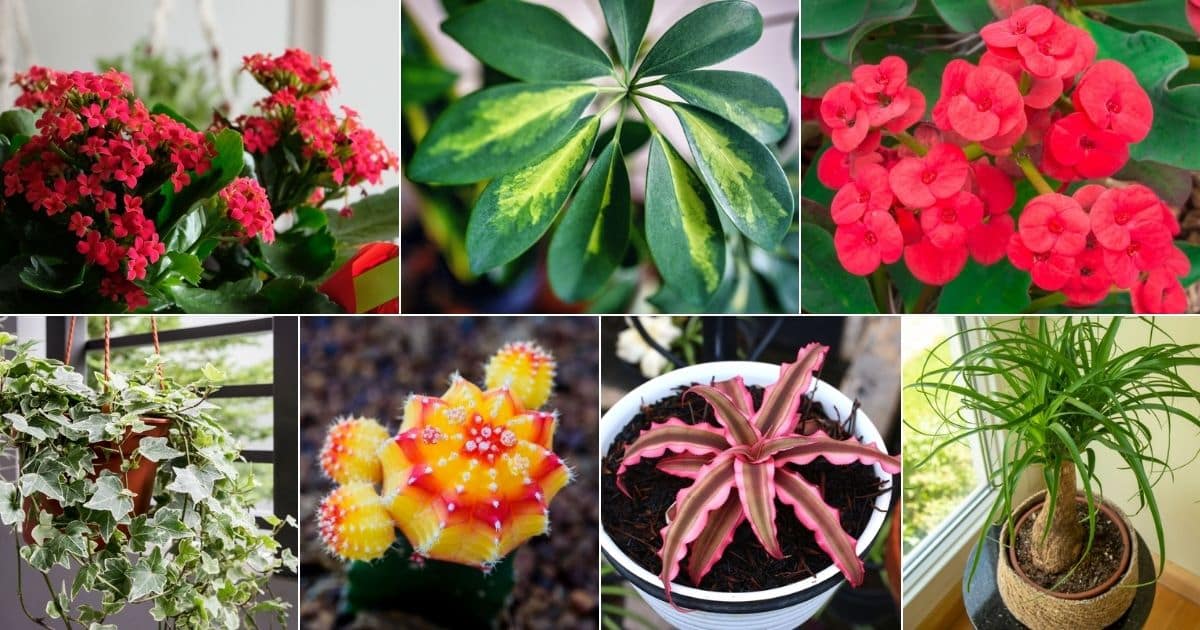
The following line-up of low-maintenance plants is just what you need to glow up your space without investing much time and energy.
Ready? Check out these low-maintenance indoor plants that will not require too much effort from you to blossom!
Jump to:
- Best Low-Maintenance Indoor Plants
- 1. Aloe Vera ‘Aloe Barbadensis Miller
- 2. African Spear ‘Sansevieria cylindrica’
- 3. Cast Iron Plant ‘Aspidistra elatior’
- 4. Corn Plant ‘Dracaena fragrans’
- 5. Dragon Tree ‘Dracaena draco’
- 6. English Ivy ‘Hedera helix’
- 7. Fishbone Cactus ‘Disocactus anguliger’
- 8. Jade Tree ‘Crassula ovata’
- 9. Ox Tongue ‘Gasteria spp.’
- 10. Ponytail Palm ‘Beaucarnea recurvata’
- 11. Umbrella Tree ‘Schefflera’
- 12. Asparagus Fern ‘Asparagus densiflorus’
- 13. Chinese Money Plant ‘Pilea peperomiodes’
- 14. Calathea ‘Calathea’
- 15. Crown of Thorns ‘Euphorbia milii’
- 16. Donkey’s Tail ‘Sedum morganianum’
- 17. Dieffenbachia ‘dieffenbachia spp.’
- 18. Earth Stars ‘Cryptanthus spp.’
- 19. Golden Pothos ‘Epipremnum aureum’
- 20. Kalanchoe ‘K. blossfeldiana’
- 21. Moon Cactus ‘Gymnocalycium mihanovichii’
- 22. Zebra Plant ‘Haworthia’
- 23. Tillandsia ‘Tillandsia’
- 24. ZZ plant ‘Zamioculcas Zamiifolia’
- 25. Kentia Palm
- Final Note
Best Low-Maintenance Indoor Plants
1. Aloe Vera ‘Aloe Barbadensis Miller
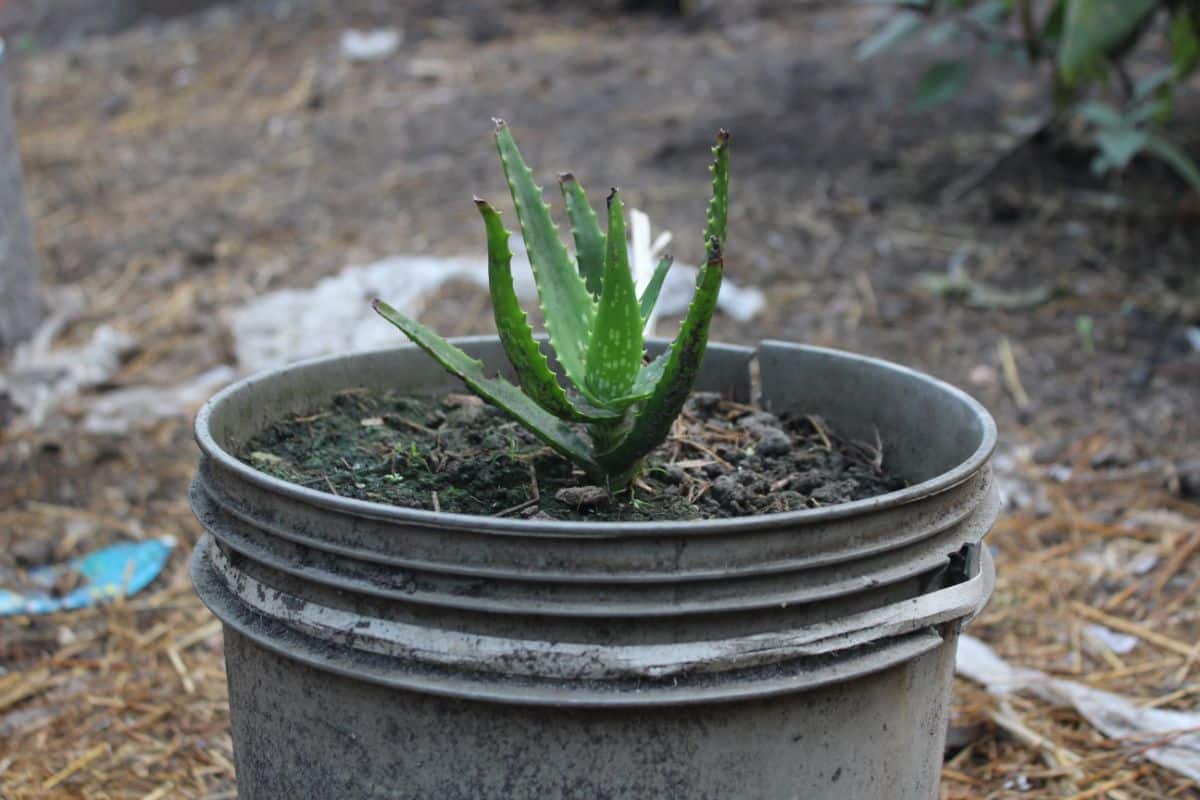
(USDA Hardy Zones: 10 - 12).
The evergreen aloe vera plant comes first on our list. This succulent native to the African continent is as popular as they come. Its growing popularity can be attributed to its versatility and the benefits it offers.
Aloe vera are herbaceous perennials. They are easy-care plants that contain a gel-like substance that is used to soothe a variety of skin irritations.
To get the plants fully established for independent growth, place them where they can get sufficient air and see that they are constantly watered. Although, you have to ensure that they stay well drained after being watered, as soggy soil might lead to root rot.
With this primary care given to the plant, you can have it grow as tall as 3ft.
2. African Spear ‘Sansevieria cylindrica’
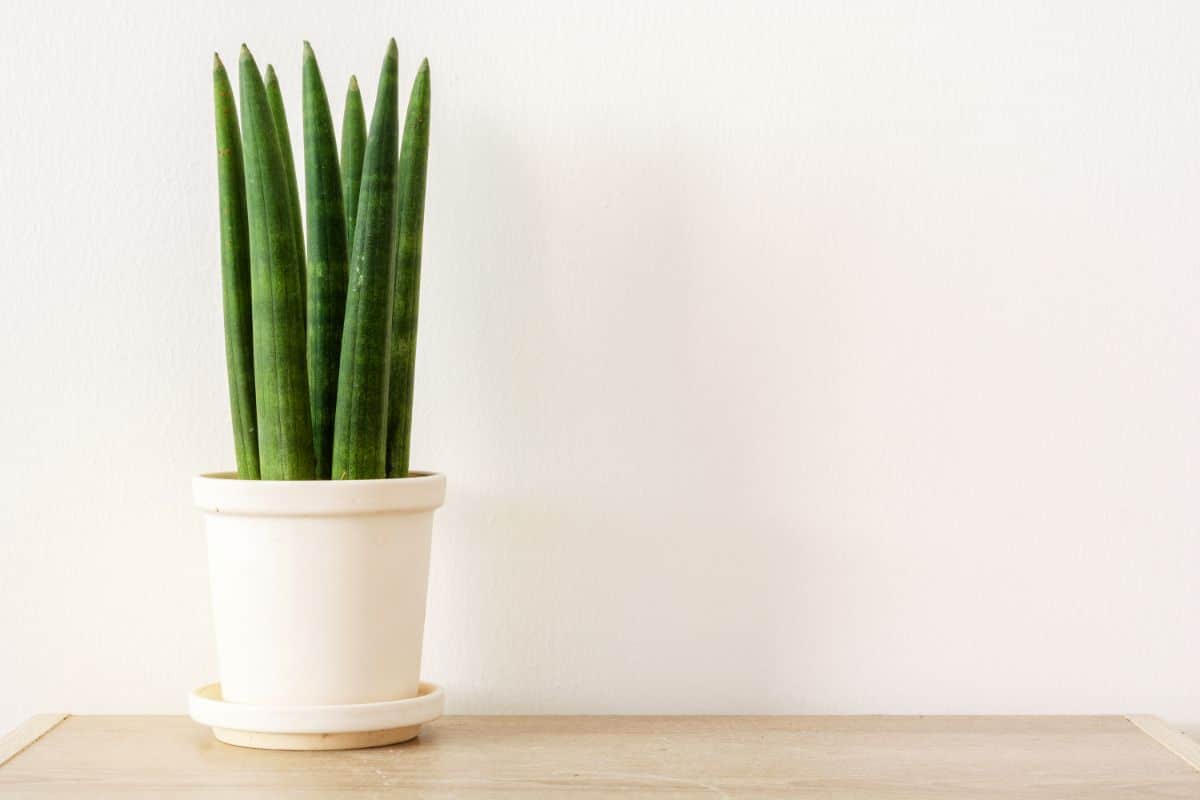
(USDA Hardy Zones: 10 - 11)
African Spears, popularly called the cylindrical snake plant primarily because of how their striped leaves are shaped, are low-maintenance succulents in every sense of the word.
They do not need constant watering; they thrive still under low light conditions and dry air and are resistant to drought.
The downside to this plant is that they are slow growers. However, with patience and the provision of full/partial sunlight, you will watch them grow beautifully, up to 4 - 6ft tall.
3. Cast Iron Plant ‘Aspidistra elatior’
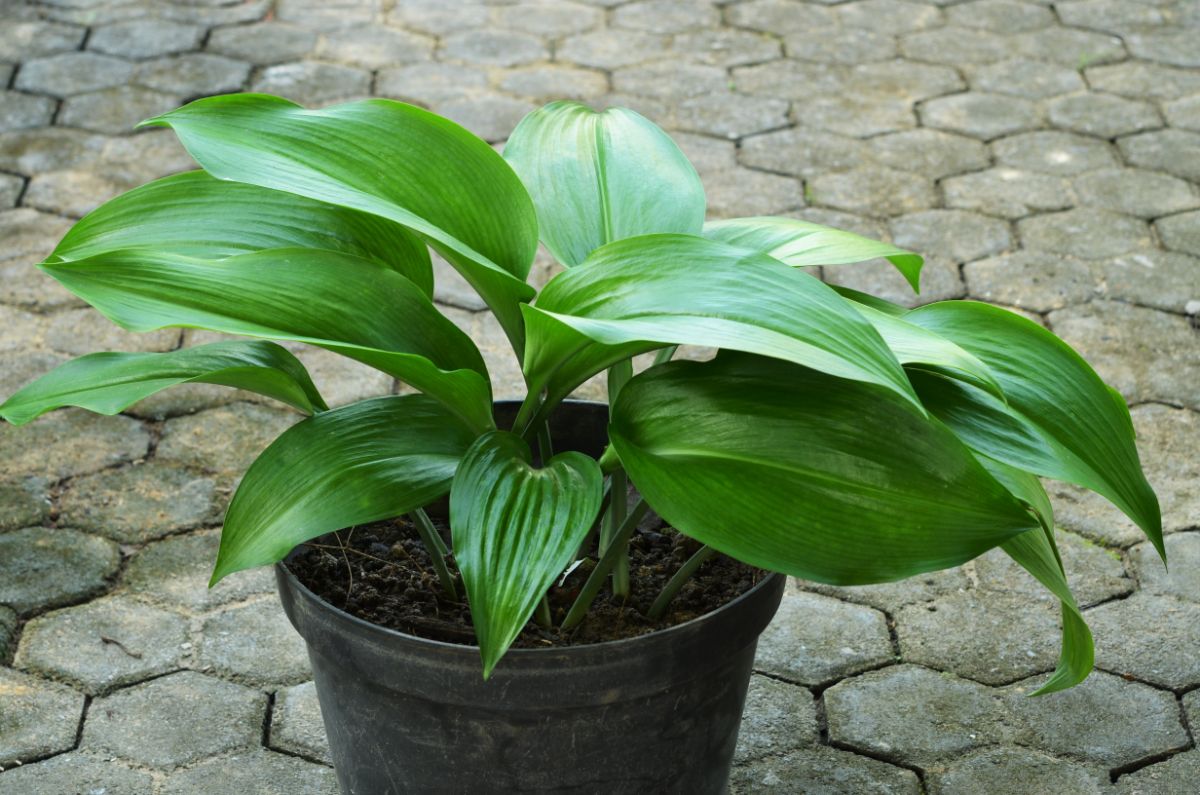
(USDA Hardy Zones: 8 - 10)
The Cast Iron plant, also known as the bar-room plant or iron princess, is a native plant of Asians. They are the exact opposite of a needy plant.
They are herbaceous perennials that need no fussing over. They thrive under low light, infrequent watering, and other unpleasant conditions, hence the name: Cast Iron, signifying their toughness.
The plant prefers partial shade exposure and has a height range of 2 - 3ft.
4. Corn Plant ‘Dracaena fragrans’
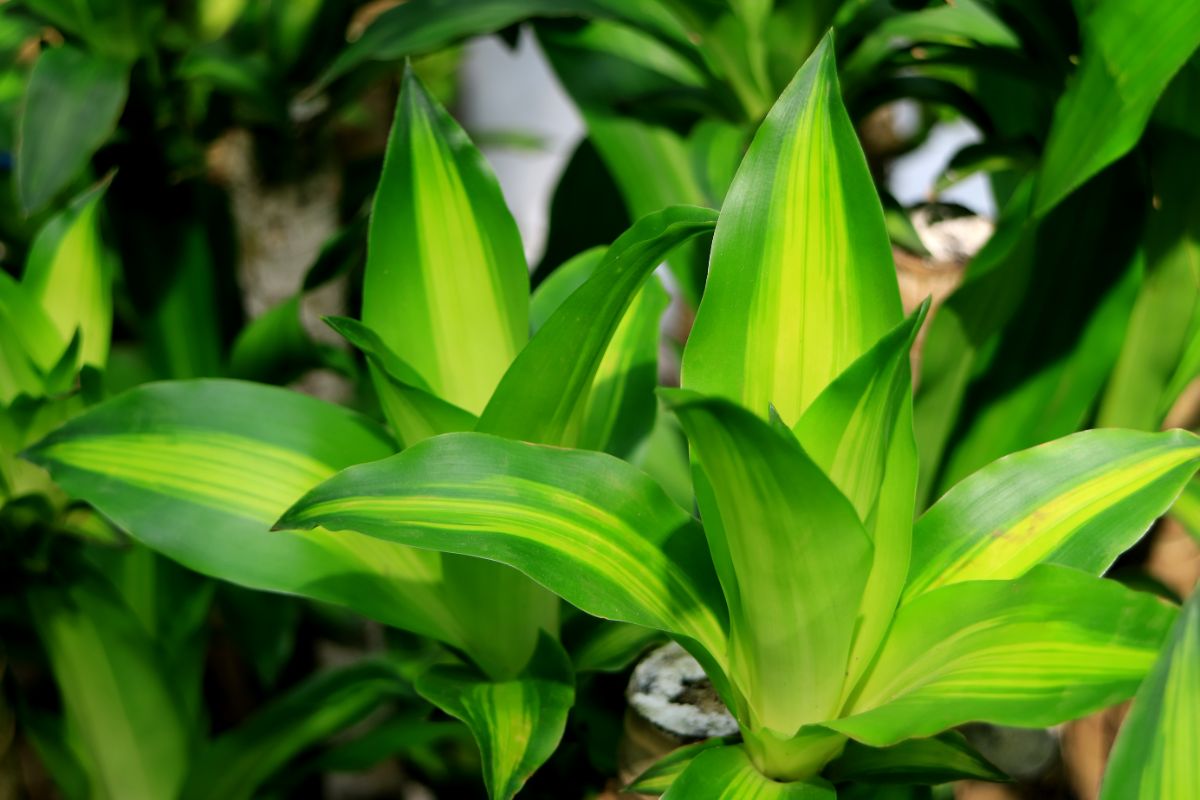
(USDA Hardy Zones: 10 - 12)
The Corn plant, native to Africa, has earned its spot on our list of low-maintenance houseplants. This evergreen shrub offers a fantastic aesthetic, which explains why it is used as a decorative piece by most people.
As the name implies, they look just like stalks of corn. The plants can attain an overall growth of 6ft, mainly when grown in a container. However, depending on the space, you can have them pruned down to your desired size.
Corn plants prefer partial sun exposure.
5. Dragon Tree ‘Dracaena draco’
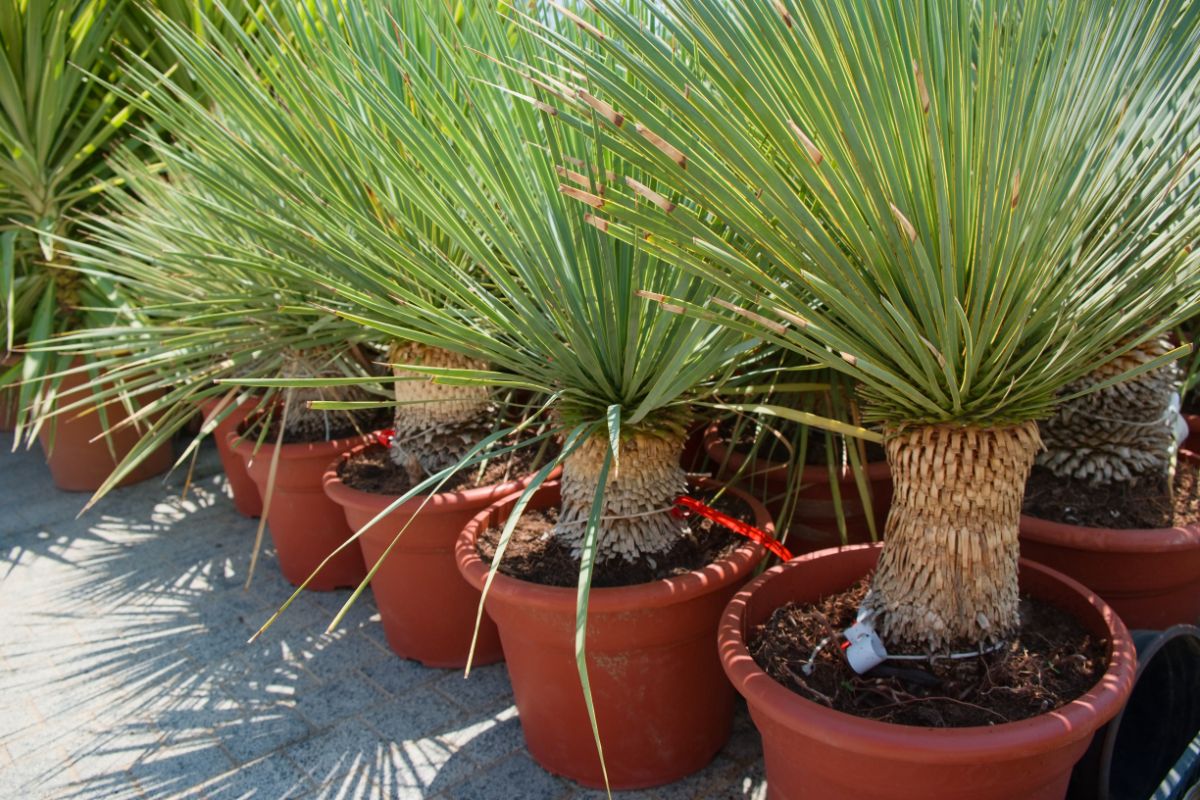
(USDA Hardy Zones: 9 - 12)
The dragon plant was derived from its long, slender leaves, which look just like dragon scales. The plants are pretty captivating and systematically retain their leaves all year long.
They are native to the Canary Islands and have an impressive height range of 15 - 50ft, although their growth pace is prolonged.
They prefer total sun/partial shade exposure. When they bloom, usually in spring, they spot tiny white flowers which give off a delightful scent.
6. English Ivy ‘Hedera helix’

(USDA Hardy Zones: 4 - 13)
English Ivy plant can be anything you want it to be. Do you need it to be a ground cover? Allow it to grow unhindered, and spread around the ground; the same process to follow if you feel it is better suited as a climbing plant.
These evergreen perennials are also low-maintenance plants that can very well tolerate certain unpleasant conditions.
The partial to complete shade-loving plants are native to Europe and Russia. If unpruned, English Ivy can climb as high as 60 - 80ft.
7. Fishbone Cactus ‘Disocactus anguliger’
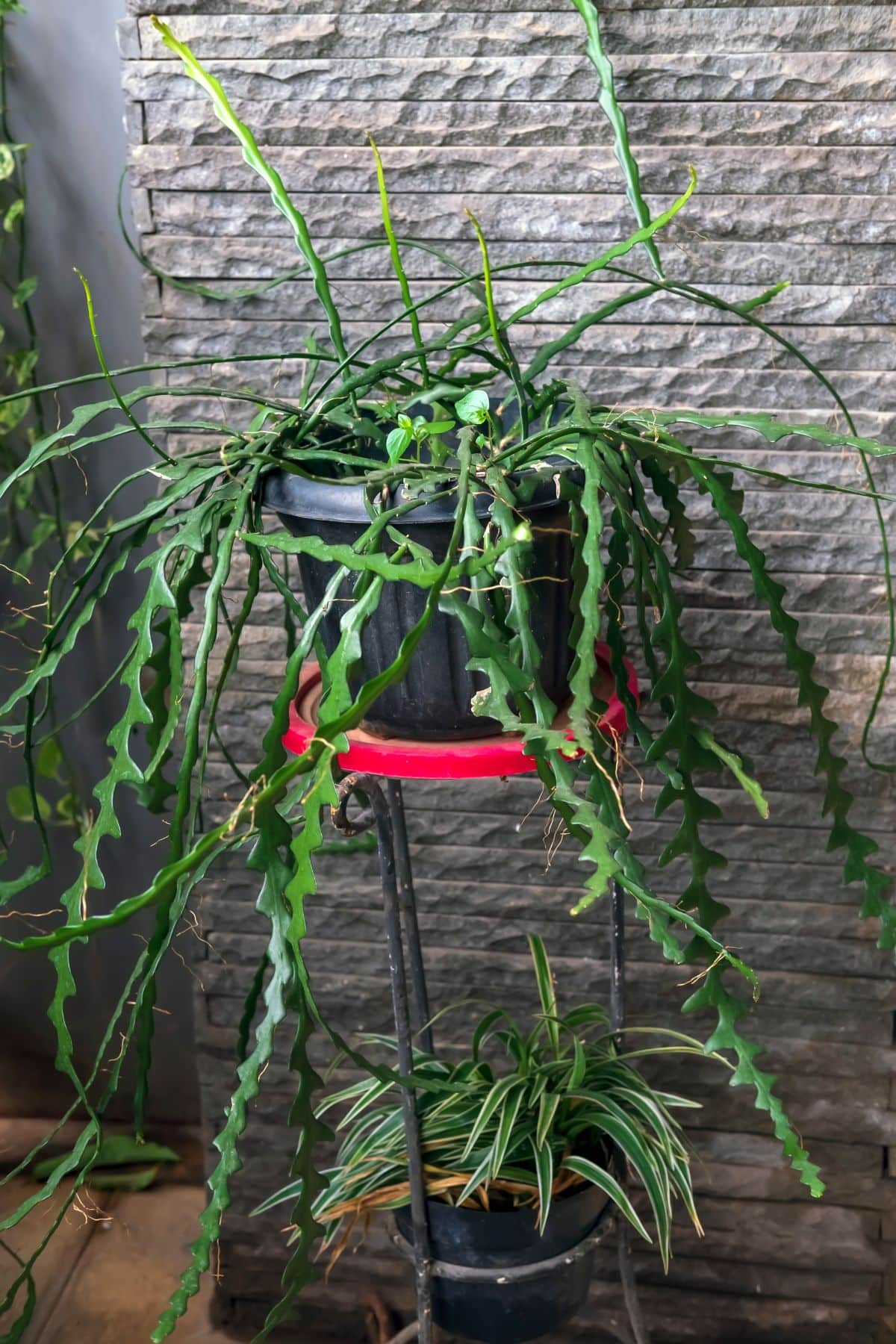
(USDA Hardy Zones: 10a - 12b)
As the name already connotes, this plant has elongated leaves with spikes making them look exactly like fish bones.
This evergreen plant can thrive when grown in containers as well as when grown in the ground. They are native to North America, can grow up to 6 inches in height, and prefers partial sun exposure.
8. Jade Tree ‘Crassula ovata’
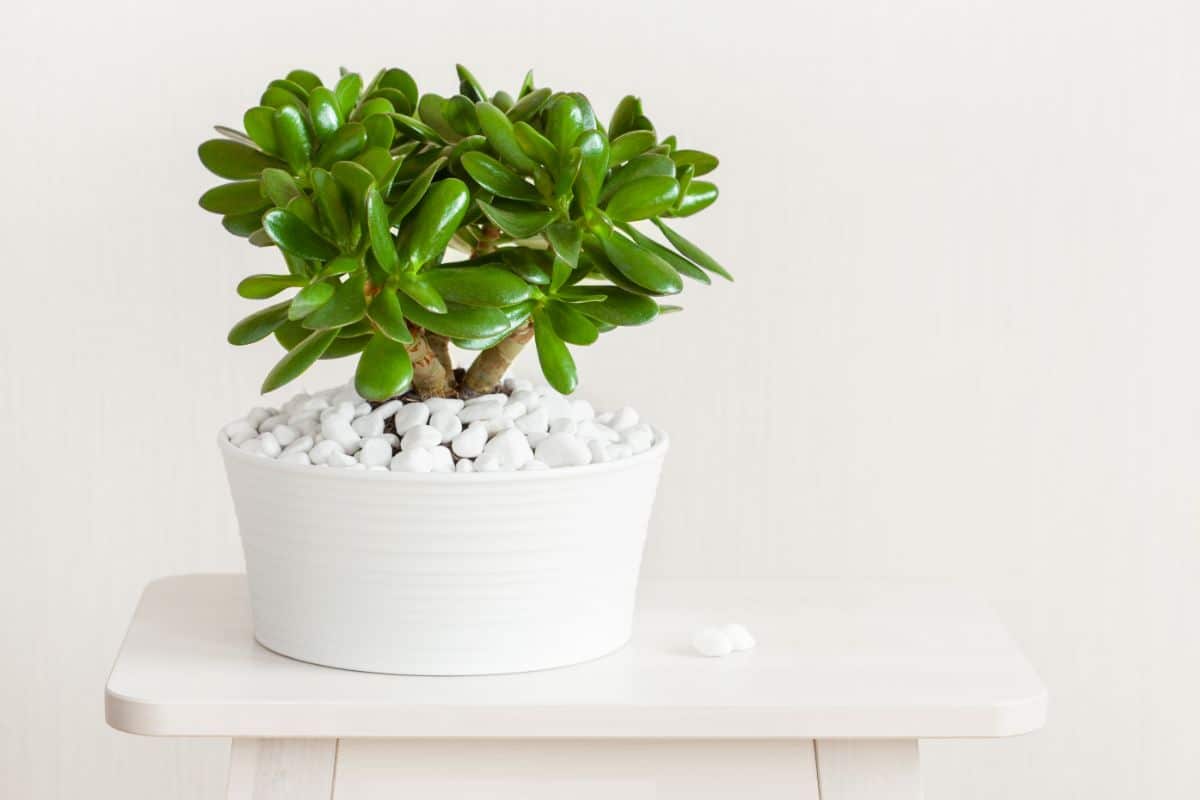
(USDA Hardy Zones: 11 - 12)
If you reside in a scorching/dry climate, you should consider growing a Jade tree.
This plant is native to South Africa. They are lovers of full sun but will thrive under partial shade.
Other features of this plant include its bright and glossy green leaves for visual delight, enduring foliage, and resistance to drought.
Best care practices for this succulent entails planting in well-drained soil and avoiding overwatering. With that, they can attain a height range of 3 - 6ft.
9. Ox Tongue ‘Gasteria spp.’
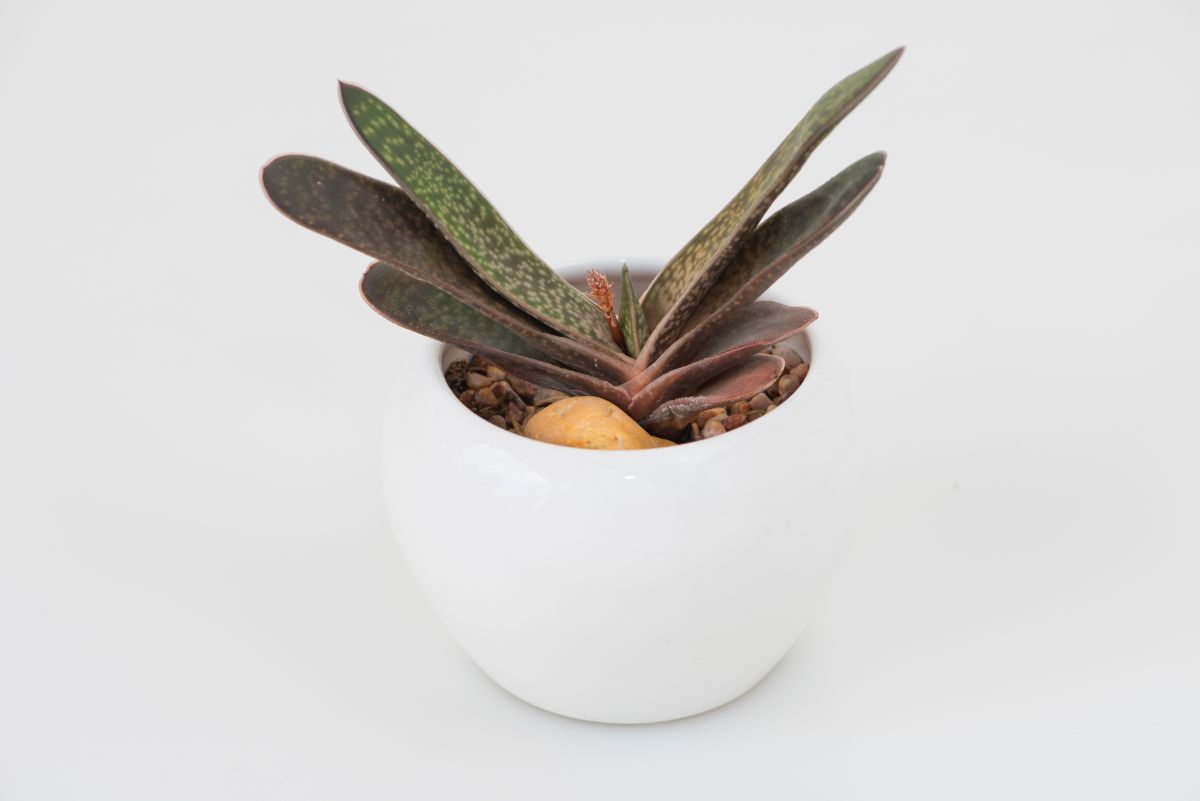
(USDA Hardy Zones: (9 - 11)
Another native South African plant. The Ox tongue is one plant that can survive growing unattended for some time. These perennials do not need to be watered often and are drought-resistant.
They prefer total sun exposure but will equally tolerate partial shade.
Their height range is 4 - 24 inches, making them perfect for ground covers.
10. Ponytail Palm ‘Beaucarnea recurvata’

(USDA Hardy Zones: 10 - 11)
This plant has long, slender leaves that look just like a ponytail. Their low maintenance quality has endeared it to many gardeners making it a commonly grown houseplant.
Unlike many indoor plants, they produce flowers, small, pretty white ones that bloom during spring.
A downside to this plant is that they are slow growers, although, if patient, you will see them attain up to 6 - 8ft height and higher if grown outdoors.
Have them planted in full sun.
11. Umbrella Tree ‘Schefflera’
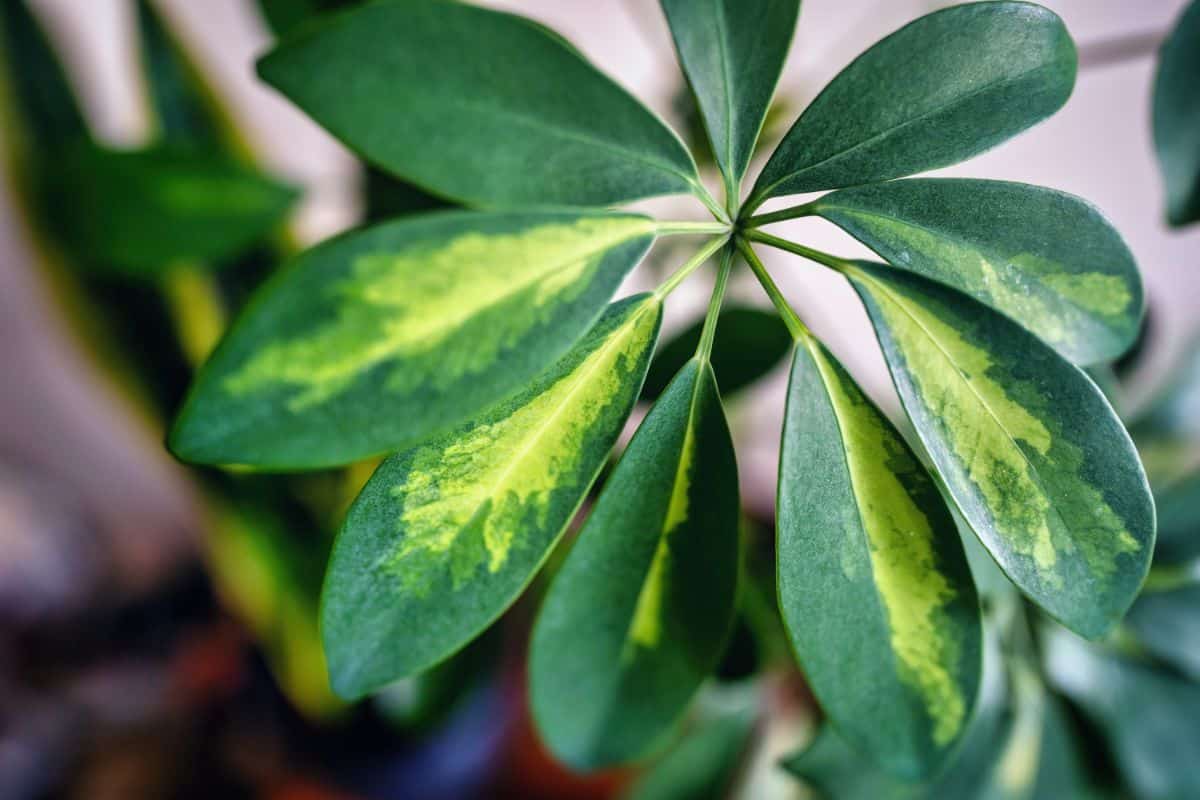
(USDA Hardy Zones: 10 - 12)
Another name for this broadleaf evergreen plant is the ‘Chinese parasol tree or octopus tree.’ Its rosette-forming foliage, together with its big, deep green leaves that are uniquely long, make them a delight to behold.
Umbrella Trees are native to East Asia. They prefer bright but indirect sunlight and have their height range set as 3-6ft.
Outstanding features of this plant include their reduced need for pesticide or fertilizer application, their drought-resistant nature, and their edible but bitter fruits. These fruits would usually be produced after the plant creates tiny white flowers during their bloom in summer.
12. Asparagus Fern ‘Asparagus densiflorus’
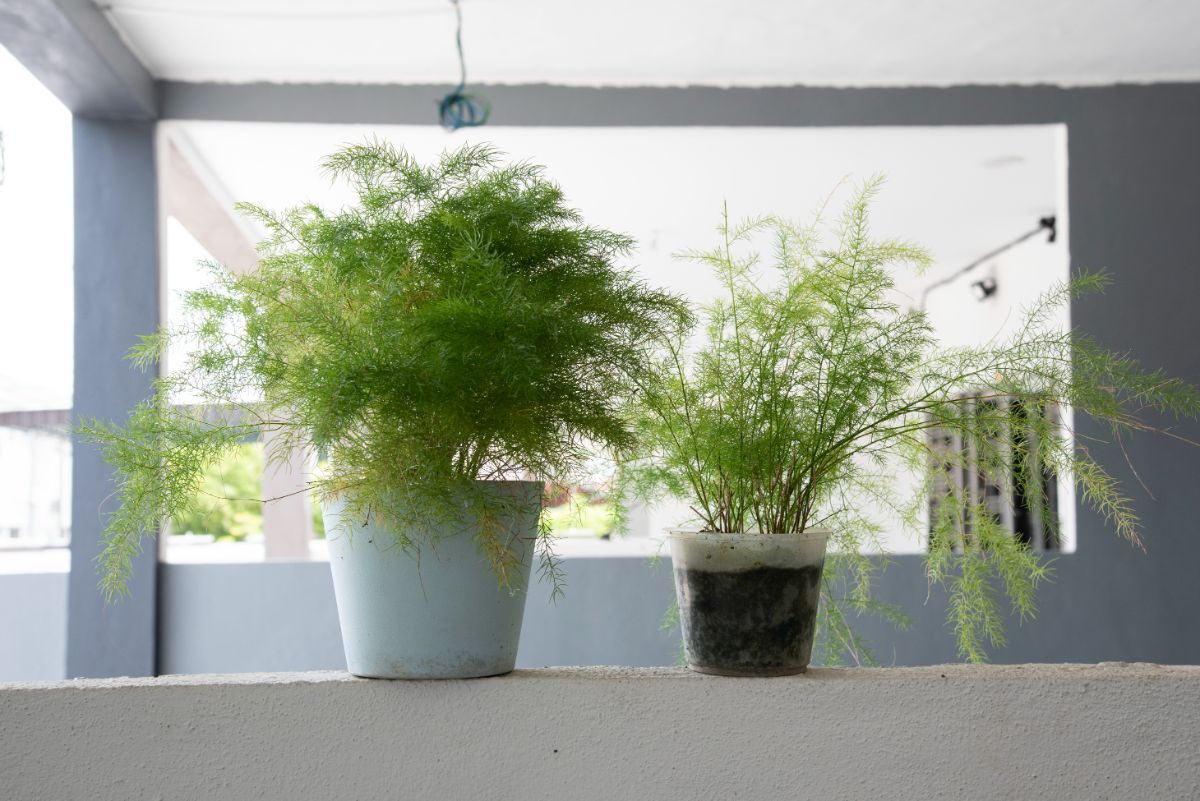
(USDA Hardy Zones: 9 - 11)
This herbaceous perennial is a great plus to your home anytime. The Lacy and intricate foliage present itself as a thick mound that makes your space look exquisite.
The plants are native to South Africa; they love bright but indirect sunlight and require sufficient watering.
Watering should be increased to once a week during the warm months and reduced during winter.
In all of this, ensure the plant never stays soggy but moist. Height size? 3ft at the most.
13. Chinese Money Plant ‘Pilea peperomiodes’
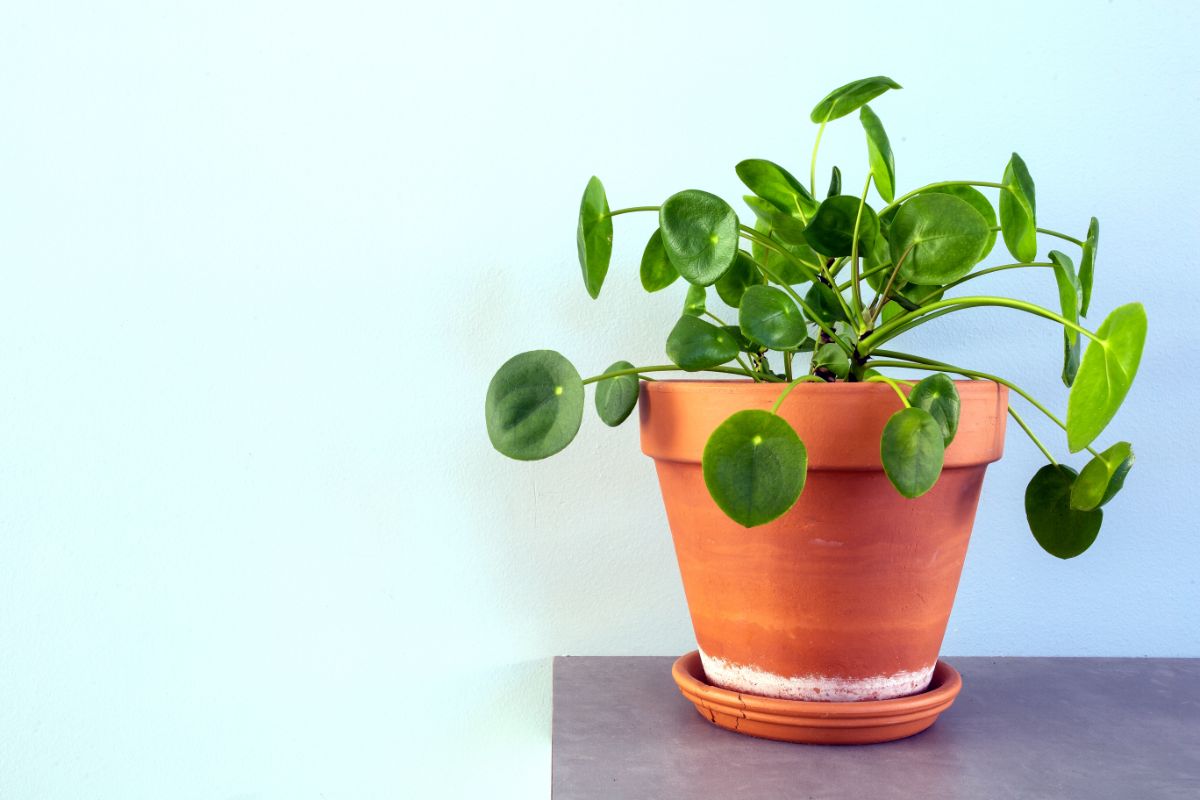
(USDA Hardy Zones: 10)
Chinese plant is a popular one. The reason is that asides from their aesthetic quality, they are also non-problematic.
This native Chinese plant is tolerant of low light or inadequate watering conditions.
Get them well established by planting them in well-drained soil and placed under bright but indirect sunlight.
Their height size is set to be 12 inches.
14. Calathea ‘Calathea’
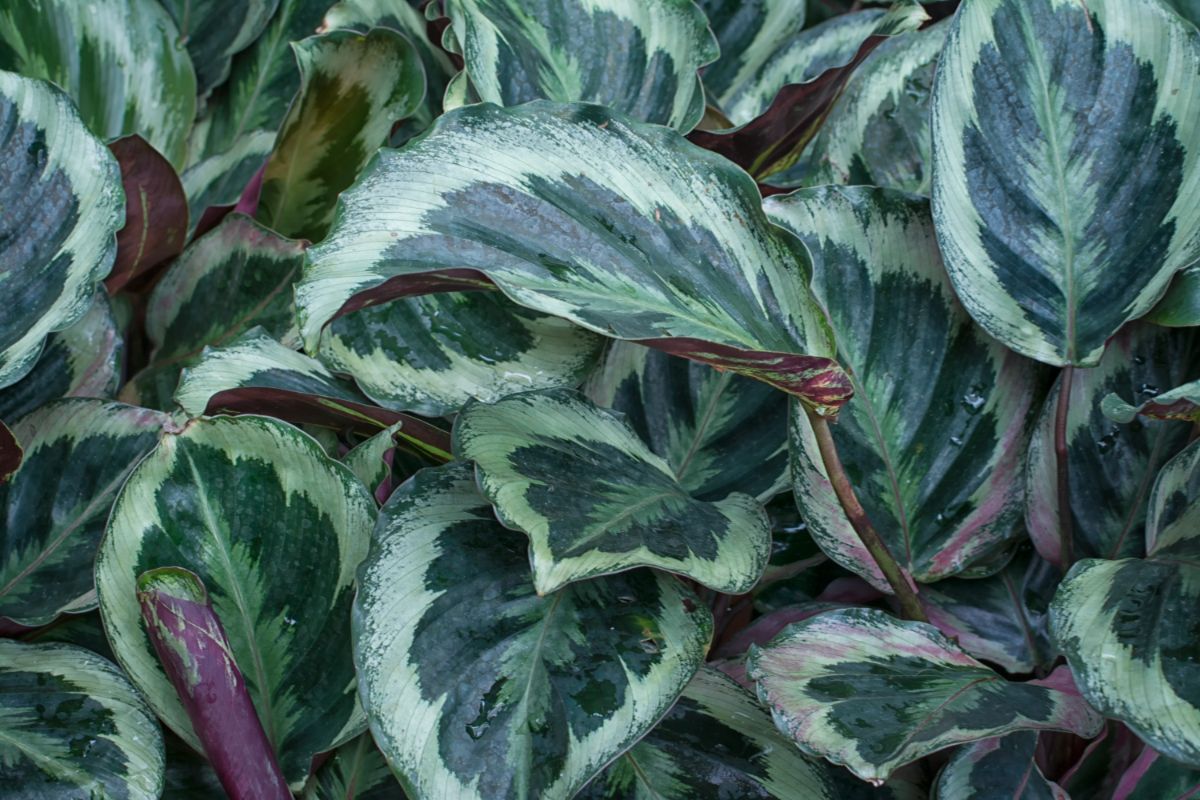
(USDA Hardy Zones: 11b - 12b)
Unique and exquisite are some words to describe this fantastic plant.
These herbaceous perennials have oblong-shaped leaves with beautiful striped and sparkling colors.
You will have no issue if you adopt ideal care practices during its active growth phase. These practices include growing them in evenly moist soil and placing them where they can enjoy partial sunlight - full shade as direct sun will see their lovely flowers wilt.
Constant watering and occasional misting are also a plus. Calatheas are native to South America and have their height range set as 6 inches-3 ft.
15. Crown of Thorns ‘Euphorbia milii’
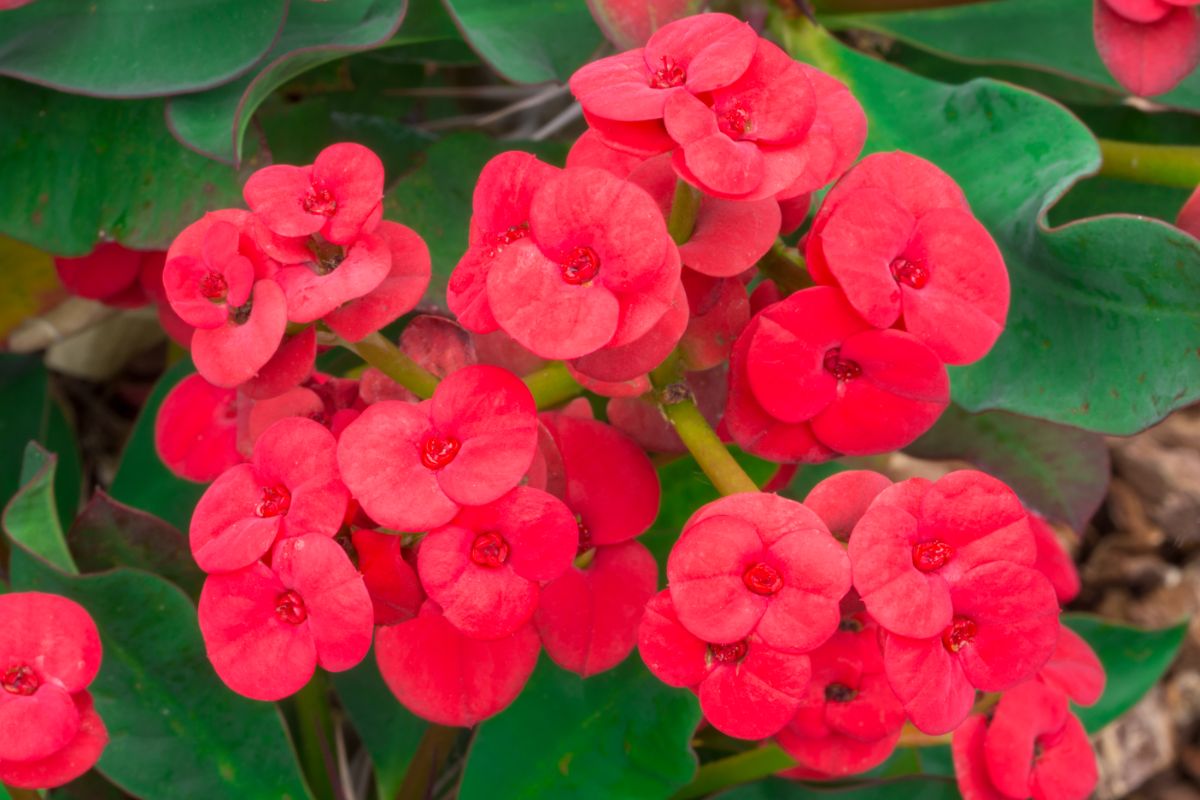
(USDA Hardy Zones: 9-11)
Key features of this plant include its drought-resistant nature and easy propagation process.
These succulents are native to Africa, Madagascar precisely, its name was derived from flowers colored white or pink that stay rooted in thorny stems.
They prefer full-partial sun exposure and can attain an overall height of 2ft when grown in containers indoors.
16. Donkey’s Tail ‘Sedum morganianum’
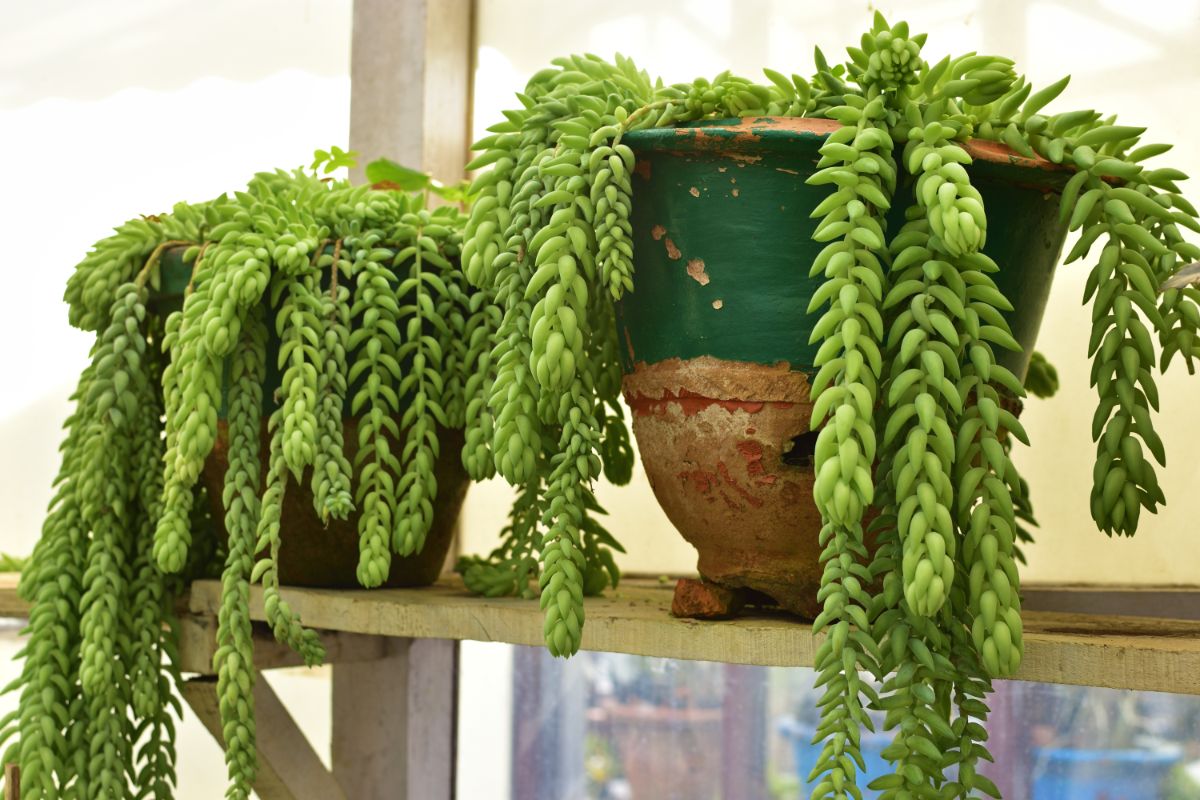
(USDA Hardy Zones: 10 &11)
Donkey’s tails are quite hardy succulents that can thrive through less-than-ideal light, water, and temperature conditions.
Other endearing features of this plant include its fast-growing nature and attractive foliage.
Native to North America, the plant prefers total sun exposure and has a height range of 1 - 4ft.
17. Dieffenbachia ‘dieffenbachia spp.’

(USDA Hardy Zones: 10 - 12)
Dieffenbachia is a native plant of central and South America. It hails from the Araceae family, the same as Philodendrons.
This plant has enormous and bright leaves, making them conspicuous.
The herbaceous perennials belong on this list as they are low-maintenance plants that thrive pretty well indoors.
Have them exposed to bright but indirect sunlight or partial shade. Height size? 3-10ft tall.
18. Earth Stars ‘Cryptanthus spp.’
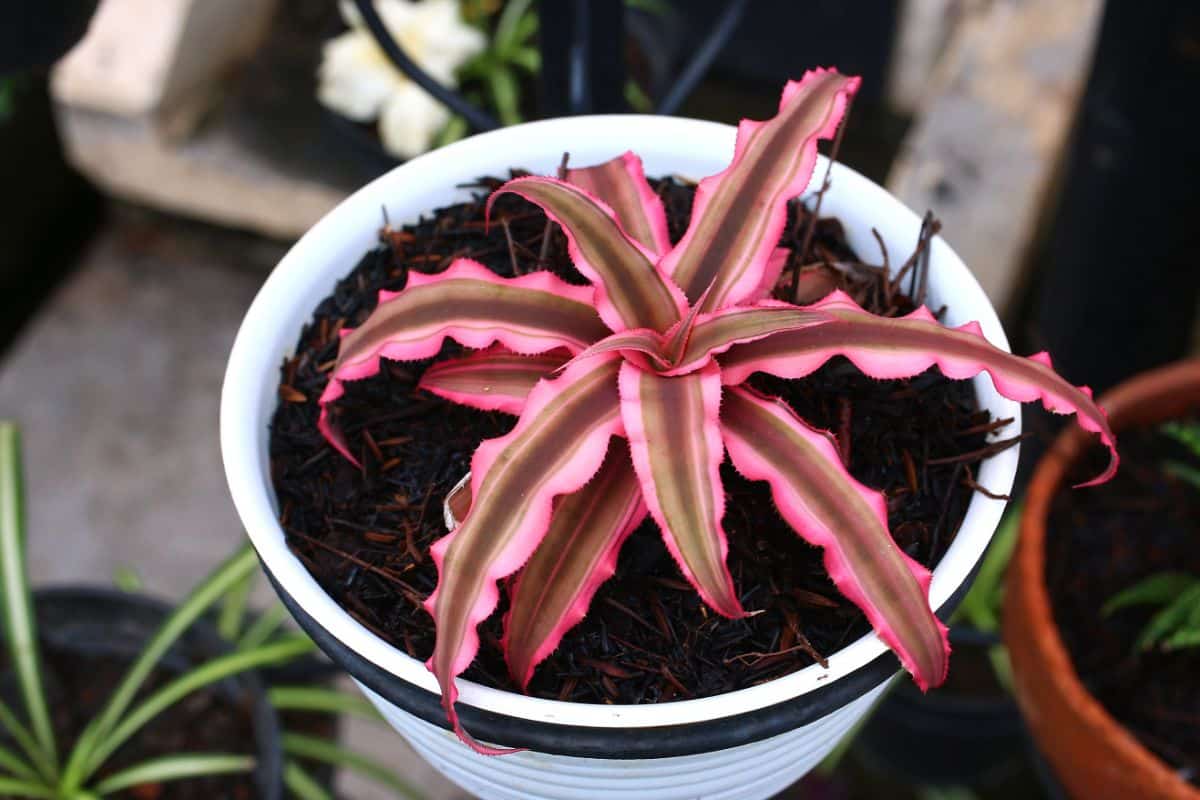
(USDA Hardy Zones: 10 - 11)
The Earth stars are boldly represented on the list of not just low-maintenance plants but versatile ones too.
The terrestrial bromeliad can survive in different habitats and is available in various colors, sizes, patterns, and shapes.
Earth stars are native to Europe and Russia; they enjoy bright but indirect sunlight and have a height range of 3 inches-3 ft based on the particular variant.
19. Golden Pothos ‘Epipremnum aureum’
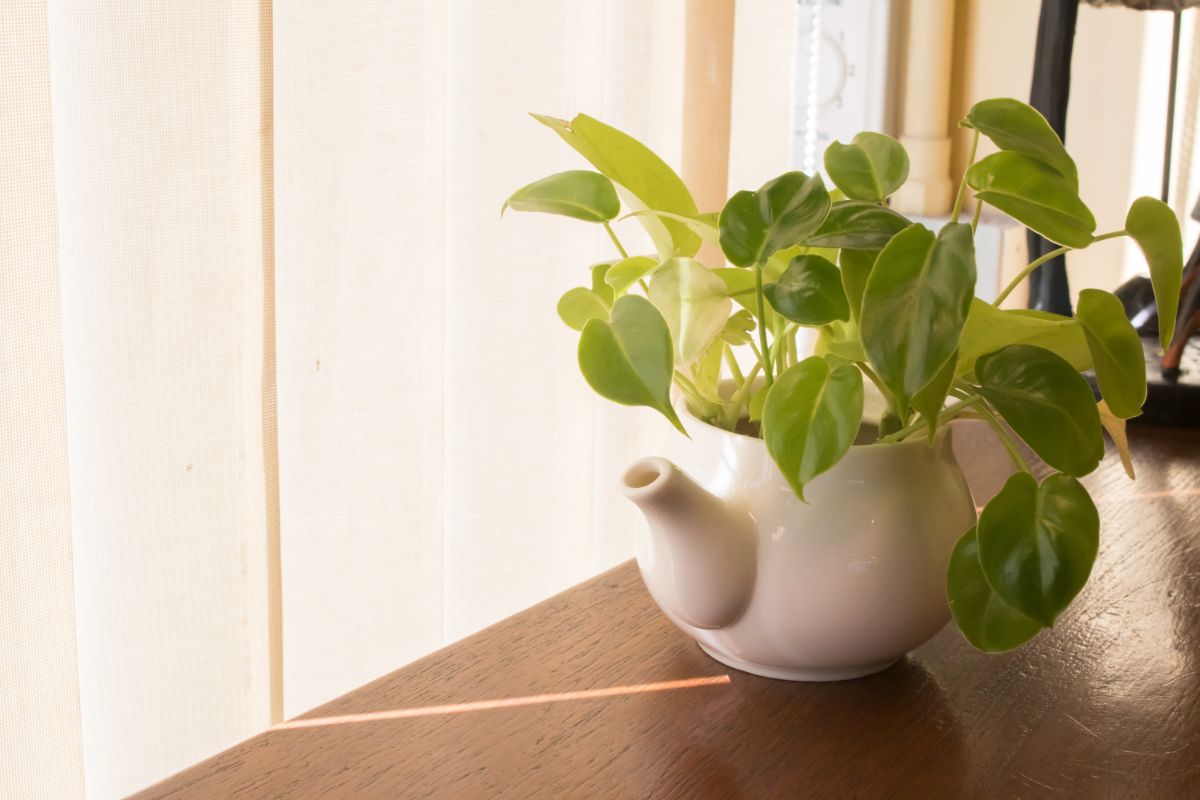
What’s not to love about this divine-looking vine with versatility and low maintenance, and visual qualities?
Golden Pothos, sometimes called the “devil’s ivy,” have heart-shaped glossy leaves colored white, yellow, or green.
They prefer full sun/partial shade and have a fantastic height range of 20-40ft.
They would very well thrive through low light and infrequent watering conditions.
20. Kalanchoe ‘K. blossfeldiana’
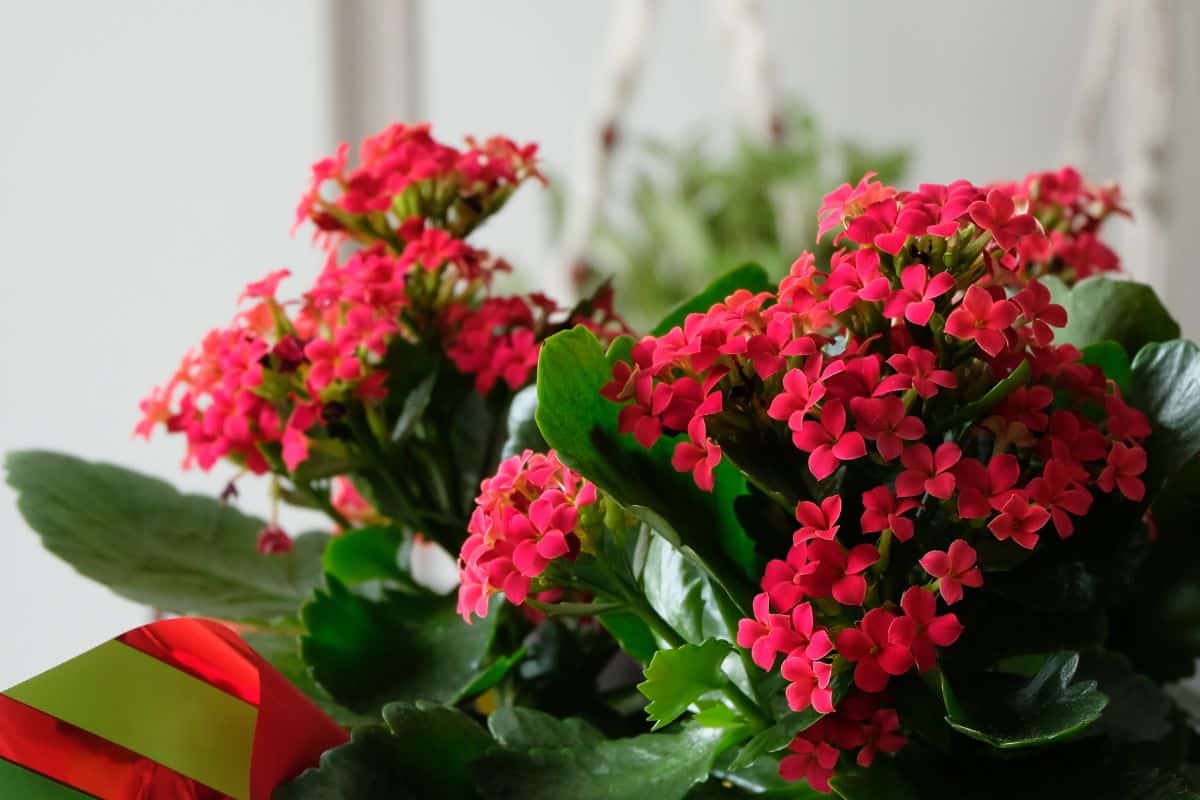
(USDA Hardy Zones: 10 - 12)
Ever heard of Christmas kalanchoe? It is another word used to describe this stunning plant that originates from Madagascar.
The perennial succulent is cherished mainly because of the radiance the flowers provide, especially in the winter season when they bloom.
Establishing them for a life of Independence entails exposing the plants to bright but indirect sunlight, monthly application of a balanced fertilizer in spring and summer, and constant but systematic watering, giving the soil time to dry out before the next.
The height range of this plant is 6-18inches.
21. Moon Cactus ‘Gymnocalycium mihanovichii’
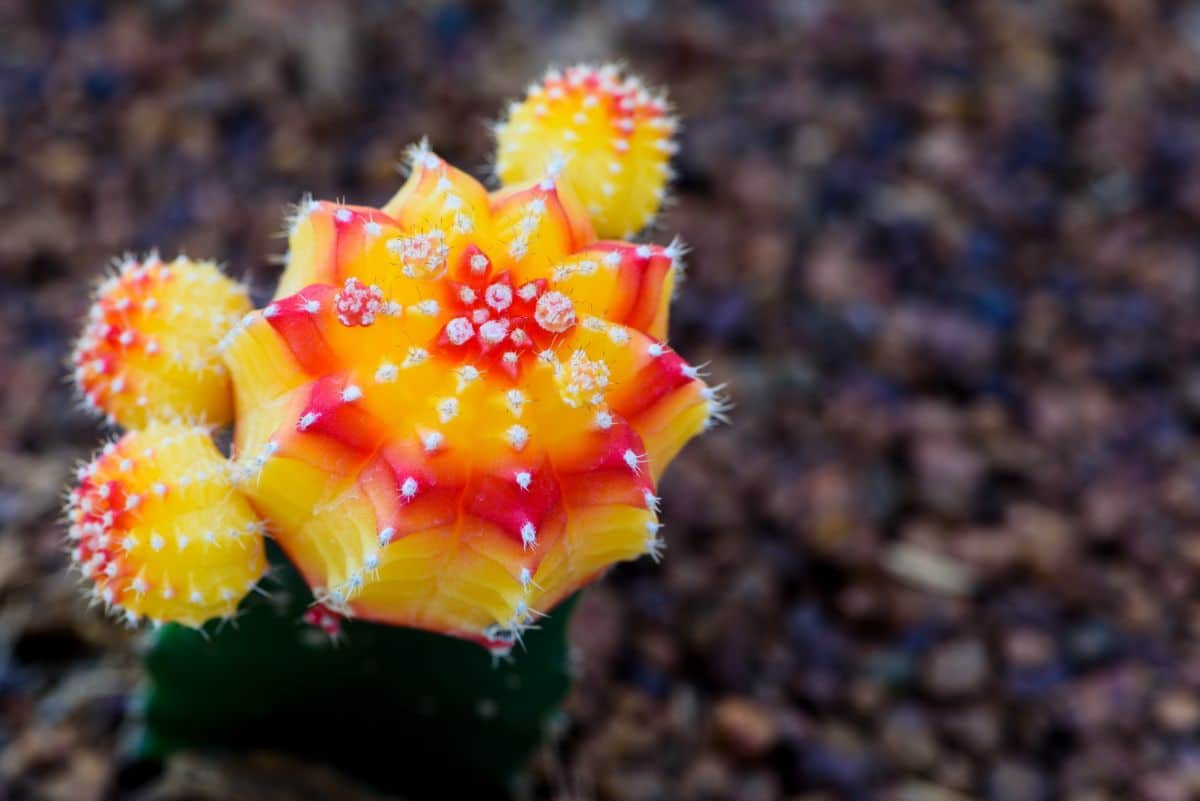
(USDA Hardy Zones: 11 - 12)
Moon Cactus are quite popular houseplants due to their compact nature. The herbaceous perennials are small, round green plants with red or, sometimes, yellow spines.
They produce equally small white flowers when then they bloom.
For best results, only water when the soil is dry and a place to enjoy bright but indirect sunlight.
Their height size does vary from one specie to another.
22. Zebra Plant ‘Haworthia’
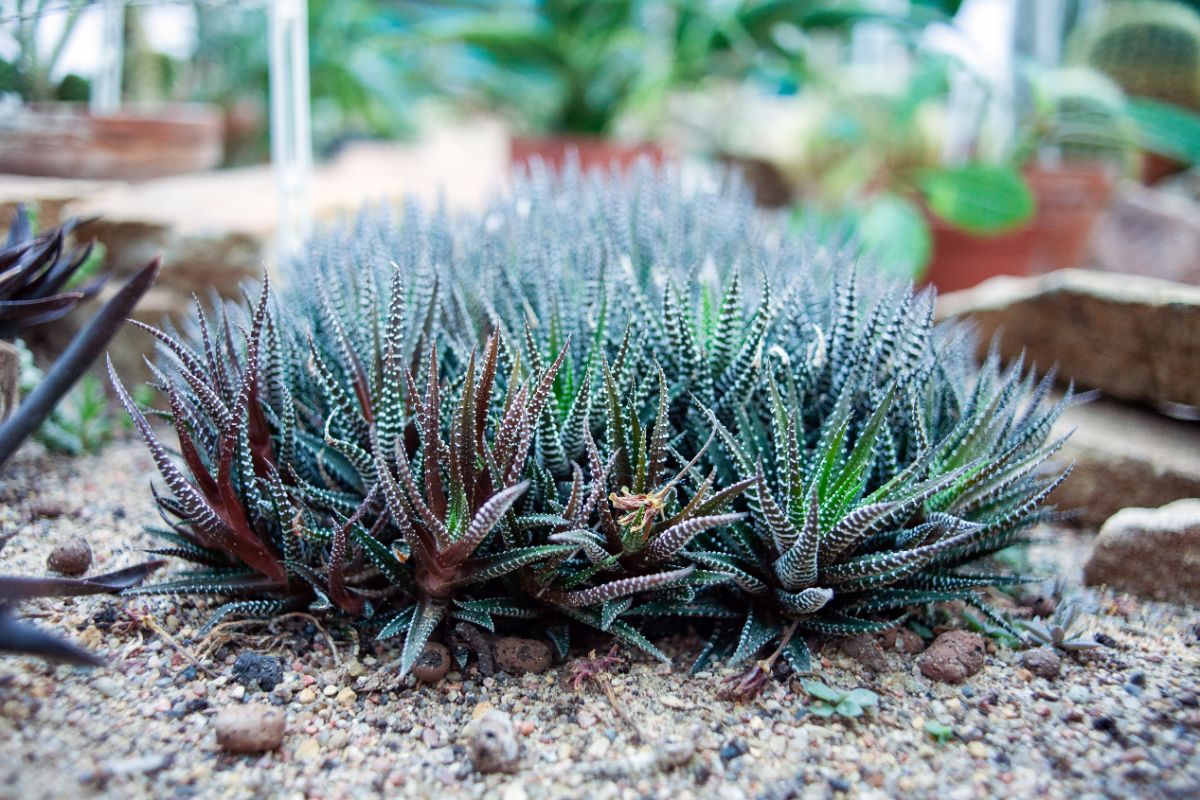
(USDA Hardy Zones: 9 - 11)
These succulent perennials belonging to the Acanthus family tree make excellent houseplants, no doubt.
They are also easy to care for plants that provide visual benefits with striking leaves with thick white stripes, just like the name connotes.
The plant is native to Africa, and it prefers bright but indirect sunlight, constant watering, and infrequent fertilizer application.
They have a height range of 3-5inches tall.
23. Tillandsia ‘Tillandsia’
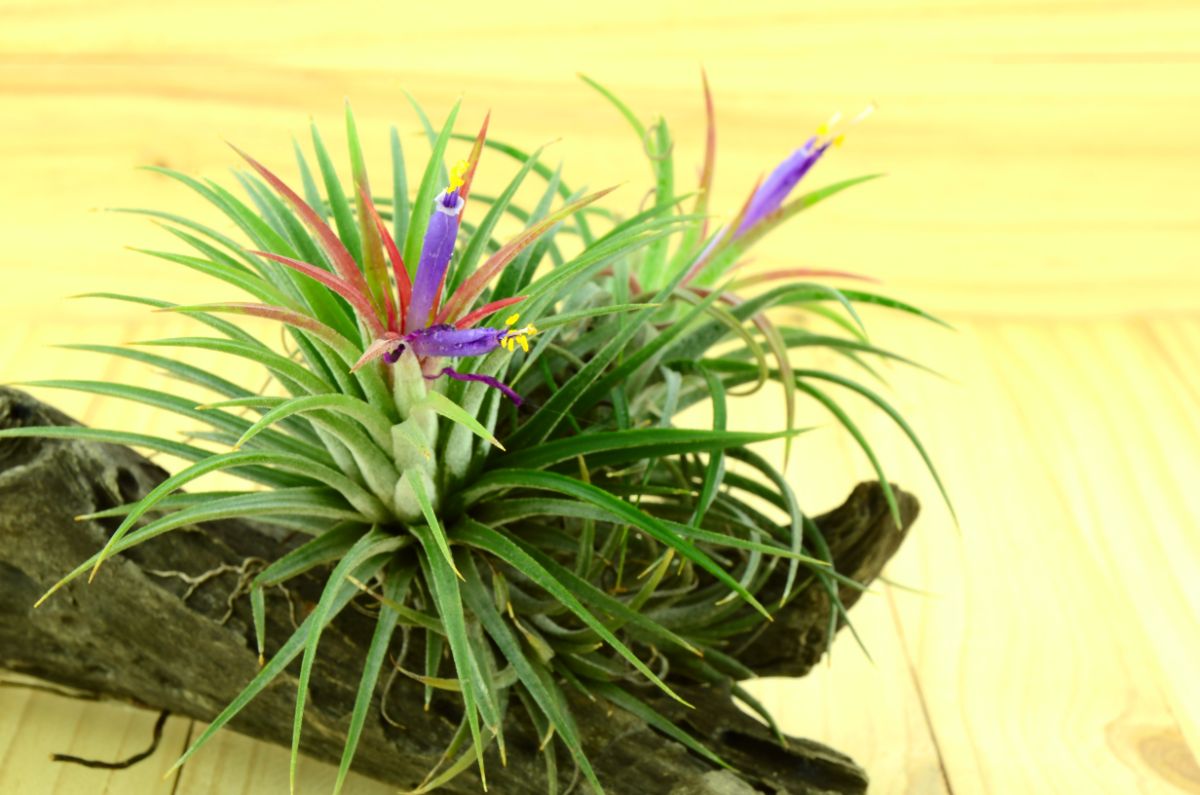
(USDA Hardy Zones: 7 - 8)
Epiphytes like Tillandsia do not need soil to grow. Native to Mexico, these herbaceous perennial plants get their prerequisite nutrients from the atmosphere and water. Now, if that does not fit the low maintenance bill, tell us what does.
With Tillandsias, also known as air plants, you can experiment with different display styles.
They prefer bright but indirect sunlight and have a height range of 15-18 inches.
24. ZZ plant ‘Zamioculcas Zamiifolia’
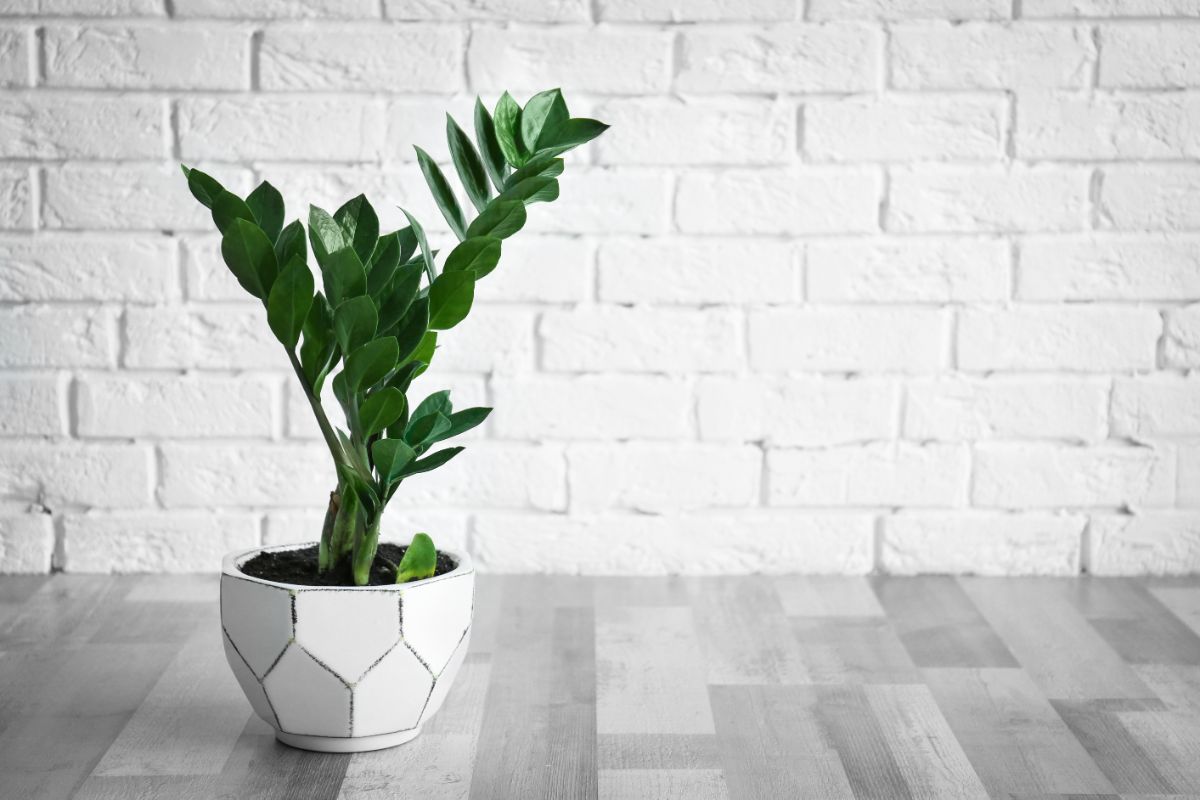
The ZZ plant is quite hardy and very independent.
Some endearing features of this plant are its air-purifying quality and its long, dark, shiny leaves with beautiful zig-zag edges.
They prefer low light conditions under a temperature range of 59-75°F.
For best results, see that it gets a monthly application of liquid fertilizer in summer and spring. Height size is about 3ft.
25. Kentia Palm
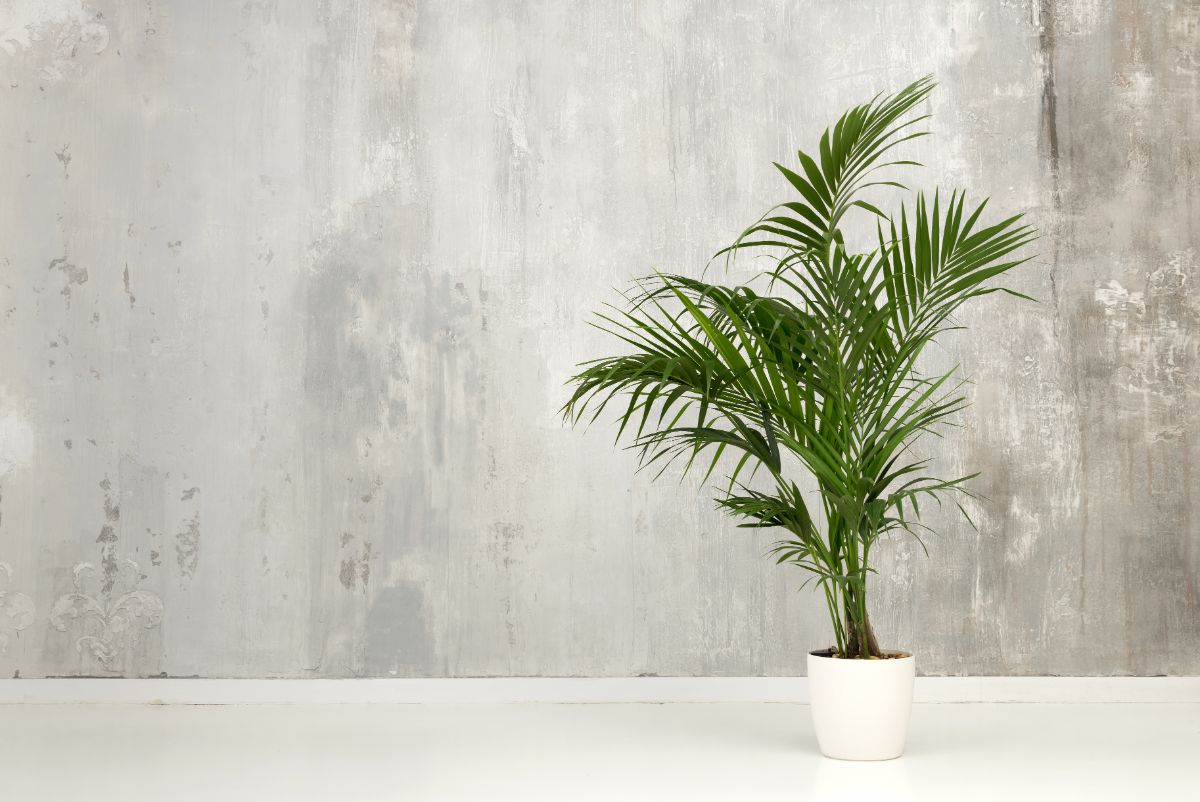
If a plant can be indestructible, that should most certainly be the Kentia Palm, and that is why we have wrapped up our list of low-maintenance houseplants with it.
Apart from their sturdy nature, they are also lovely plants with fronds that grow from the base and arch forward artistically.
Best care practices for this plant include avoiding soggy soil and direct light.
Kentia Palm will grow up to 3m tall and, thankfully, do not take up a lot of ground space.
Final Note
Houseplants are becoming even more popular as the days go by.
An added advantage to the beauty of the ones above adds is that they are houseplants that require minimal care and attention.
So, whether you are a novice at growing plants or simply too busy to dot on them, these are significant options that you can choose from to enjoy the best of both worlds - a touch of vibrancy and a feel of nature in the home plus, time - off from constantly caring for them.




